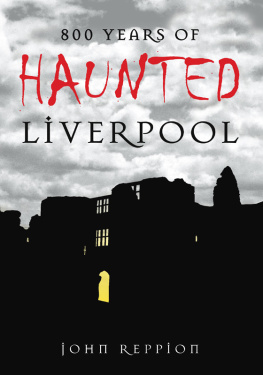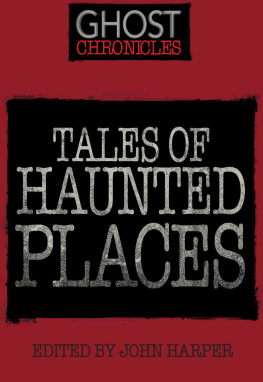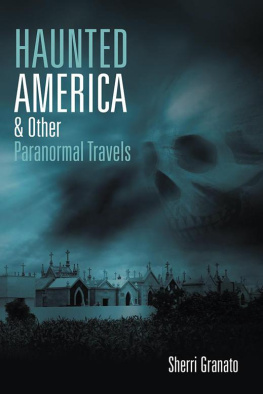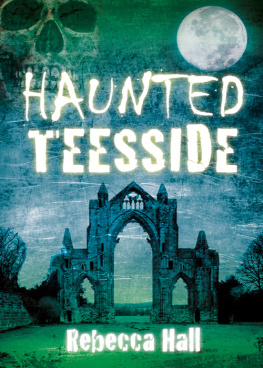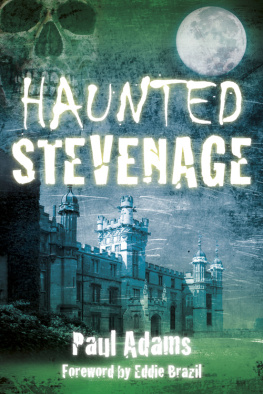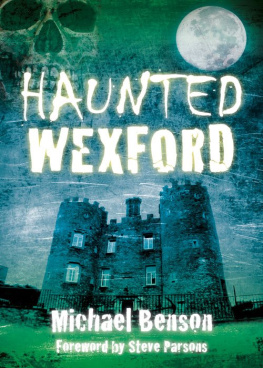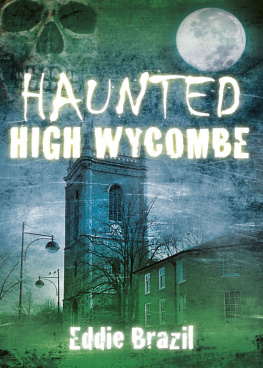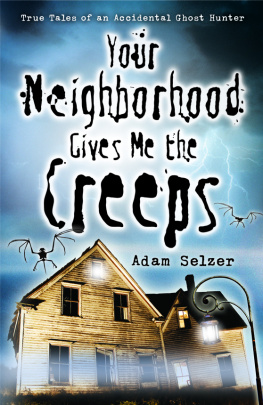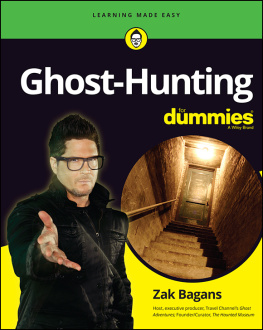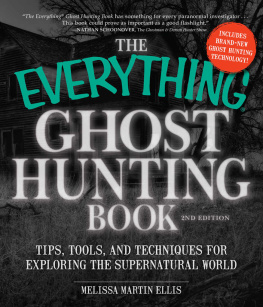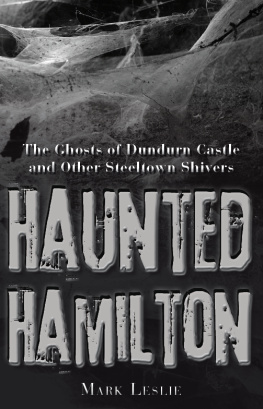800 YEARS OF
HAUNTED
LVERPOOL
800 YEARS OF
HAUNTED
LVERPOOL
JOHN REPPION

Springheeled Jack. (courtesy of David Hitchcock)
First published in 2008
The History Press
The Mill, Brimscombe Port
Stroud, Gloucestershire, GL5 2QG
www.thehistorypress.co.uk
Reprinted in 2008, 2009
This ebook edition first published in 2014
All rights reserved
John Reppion, 2008, 2014
The right of John Reppion to be identified as the Author of this work has been asserted in accordance with the Copyright, Designs and Patents Act 1988.
This ebook is copyright material and must not be copied, reproduced, transferred, distributed, leased, licensed or publicly performed or used in any way except as specifically permitted in writing by the publishers, as allowed under the terms and conditions under which it was purchased or as strictly permitted by applicable copyright law. Any unauthorised distribution or use of this text may be a direct infringement of the authors and publishers rights, and those responsible may be liable in law accordingly.
EPUB ISBN 978 0 7509 5991 9
Original typesetting by The History Press
CONTENTS
ACKNOWLEDGEMENTS
Ryan Alexander, Carrie Ali, Richard Baker (for all his tales of South Liverpools parkland ghosts), Neil Bascombe, Dr Richard Benjamin, Janet Bord at the Fortean Picture Library (for all her help and generosity), Fiona Campbell, Ramsey Campbell, Leslie Carter, Paul Cornell, Dave Cotterill, Mike Dash (for all his assistance with the Spring Heeled Jack portion of this book), Mike Faulkner, Fortinian, Google.com, Bill Harpe, Jeff Jones, David Leck, Pdraig Malid, Darren Mann at ParanormalDatabase.com (for helping me out with my references), Lisbeth Reppion, Douglas Rednour, Wendy S., Brian J. Showers (for all his inspiration, encouragement and making it possible for me to actually write this book in the first place), Brad Steiger, Caroline Symcox, Pippa Taylor, Patrick Trollope at SouthportReporter.com, Brenda W., Ross Walsh, David Wood, Jamey Wood, Nathan Ward, Wikipedia.org, Jonathon Wild, Ann Winsper and Para Science, all the magnificent artists who came up with such fantastic artwork at such short notice, the knowledgeable members at www.yoliverpool.com/forum, the helpful staff at Liverpools numerous libraries, my friends, my family, anyone else who Ive forgotten (apologies) and last, but by no means least, my long-suffering, endlessly supportive, helpful and hugely talented wife.
INTRODUCTION
This book was written between August 2007 and March 2008 when the words Capital of Culture were seemingly inescapable in the city of Liverpool. In addition to the information gathered from Google, Wikipedia, good old-fashioned trips to bookshops and numerous libraries, Haunted Liverpool could not have been written without the co-operation of the many kind Scousers who shared their stories with me. Thank you to everyone who picked up one of my handbills in a caf, staffroom, shop, etc or read one of my posts online and decided to get in touch; I genuinely could not have done this without your help. Special thanks must go to the members of the Yo Liverpool online forum (www.yoliverpool.com/forum) whose assistance, advice and expertise proved truly invaluable.
BCE (Before Common Era) is used throughout as a non-religious alternative to BC (Before Christ). Similarly, CE (Common Era) is used as a non-religious alternative to AD (Anno Domini).
John Reppion, 2008
ONE
LIVERPOOL CITY OF GHOSTS
Liverpools name is thought by some historians to derive from Liuerpul (meaning muddy pool) in reference to the Mersey inlet, upon which the settlement was originally built. Others claim that the community was originally called Eelverpool in honour of the abundance of large eels which could be caught in the local waterway. Slightly more convincing to my mind is the idea that liver comes from the word lither meaning lower, which would have distinguished the place from the nearby Hitune or High Town, known today as Huyton.
The story of Liverpool began in earnest when King John, arch enemy of the fabled Robin Hood, took control of the area in 1207. Though it would be some 400 or so years before Witch-finder Gen. Matthew Hopkins, plied his trade across the country, it is perhaps worth noting that Johns short reign did see some of the first officially sanctioned executions of accused witches on English soil. The King, who was also Lord of Ireland, needed access to a port from which he could easily send men and equipment to Eire. John procured the area from local landowner Henry Fitzwarin and on the 28 of August 1207 presented his letters patent (a type of legal document in the form of an open letter) at Winchester. The manuscript invited people to come and settle in the hamlet of Liverpool where, for a rent of one shilling a year, they could enjoy a new life by the River Mersey. Johns reign lasted for nine more years but, despite all the effort he had exerted in founding Liverpool, he seldom visited the region. The King died in October 1216 at Newark Castle in Nottinghamshire; his restless spirit is said to haunt one of its crumbling towers to this very day.
Liverpools own castle was built under the orders of the Earl of Derby, William de Ferrer, during the reign of King Johns successor Henry III. The castle stood until 1725 at the junction of todays Castle Street (which follows the line of the long vanished channel or pool after which the city is named) and Lord Street in the city centre. The site is now known as Derby Square and is occupied by the Queen Victoria Monument, erected in 1906. The castle fell under the control of Royalist Cavaliers during the English Civil War, following an eighteen-day siege by Prince Rupert the Mad Cavalier. Ruperts raid left a lasting impression on the city and the spectres of fallen Royalists have been reported as far afield as the southern village of Woolton (see Ghosts of Woolton Village, page 38). Surprisingly, a modern-day visit to the castle is not entirely out of the question as a full-sized replica of its ruins exists some 30 miles (48km) north-east of the original site in the village of Rivington, Chorley.
The port of Liverpool benefited from improved trade with America and the West Indies during the latter part of the 1600s and the citys economy steadily improved. It was October 1699 when the first recorded slave ship, Liverpool Merchant, left the port bound for Africa. The ship arrived in Barbados with more than 200 chained and starving Africans in her hold, who were treated as cargo rather than human beings. Soon Liverpool was second only to London in terms of its wealth and, though much is made today of the claim that no slave was ever bought or sold within its boundaries, it is undeniable that the city profited hugely from the barbaric trade. There are those who tell stories of tunnels leading from the docklands into holding cells secreted in the vaults beneath certain buildings, tales of long-forgotten flooded cellars found with the remains of rusted chains hanging upon their slime-covered walls (see Terror in Toxteth, page 44). Whoever you believe, there is little denying that the spectre of slavery still haunts this city, one way or another. The Albert Dock is now home to the International Slavery Museum (www.liverpoolmuseums.org.uk/ism), which opened its doors to the public in August 2007, some 200 years after the Abolition of the Slave Trade Act was originally passed by the House of Lords.
Liverpools success as a port continued through the 1800s and on the 15 September 1830 the worlds first intercity passenger railway was officially opened between Liverpool and Manchester. A train can still be caught on the original line which runs from todays Liverpool Lime Street Station to Manchester Piccadilly. Back in 1830, the launch was a star-studded affair, with many of the eras personalities embarking on the inaugural journey. Taking advantage of one of the locomotives temporary stops, noted member of parliament and statesman William Huskisson alighted from his carriage and wandered down the tracks. He was engaged in conversation with Prime Minister Arthur Wellesley, the Duke of Wellington, conducted via the dukes carriage window, when he was struck by an oncoming steam engine. Huskissons place in the history books was assured by the fact that he was not only the worlds first passenger railway fatality, but was lethally wounded by none other than George Stevensons famous
Next page
